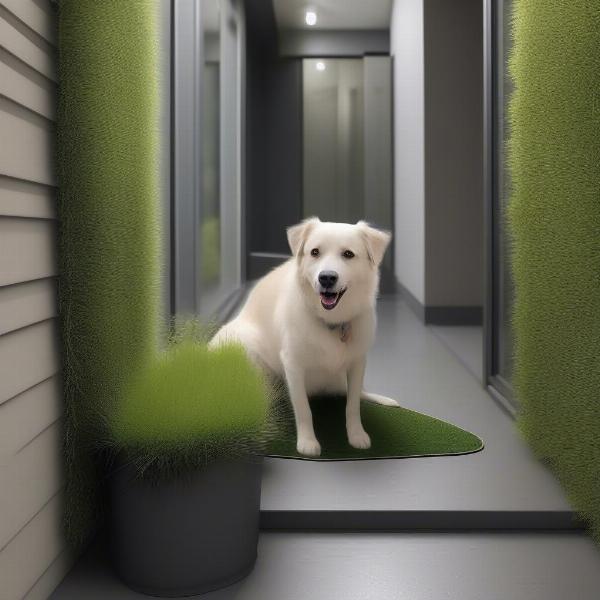Dog toilet training grass can be a lifesaver for apartment dwellers, busy pet parents, or those with limited outdoor access. Whether you’re considering a patch of real grass or a synthetic alternative, this guide provides everything you need to know to successfully toilet train your dog using grass. We’ll cover the benefits, different options available, and step-by-step training tips to make the process smooth and effective.
Choosing the Right Dog Toilet Training Grass
Selecting the right grass for your dog’s toilet training depends on your lifestyle, living situation, and your dog’s preferences. There are two main options: real grass and synthetic grass. Real grass offers a natural feel and scent that can be appealing to dogs, but requires regular maintenance, sunlight, and can be messy. Synthetic grass, on the other hand, is low-maintenance, durable, and easy to clean. Consider factors like space, budget, and your willingness to upkeep the grass when making your decision.
 Real Grass Dog Toilet Training
Real Grass Dog Toilet Training
Which type of grass is best for indoor use? Synthetic grass is generally the preferred choice for indoor use due to its easy maintenance and mess-free nature.
Training Your Dog to Use the Grass Toilet
Regardless of whether you choose real or synthetic grass, the training process is similar. Start by introducing your dog to the grass toilet. Place it in a designated area and encourage your dog to sniff and explore it. When your dog eliminates on the grass, immediately praise them with positive reinforcement and a treat. Consistency is key. Take your dog to the grass toilet at regular intervals, especially after waking up, eating, and playing.
How long does it take to train a dog to use a grass toilet? The training timeline varies from dog to dog, but with patience and consistency, most dogs learn within a few weeks.
Dealing with Accidents
Accidents are bound to happen during the training process. If your dog eliminates elsewhere, do not punish them. Instead, calmly clean the area with an enzymatic cleaner to eliminate the odor and deter future accidents. Then, redirect your dog to the grass toilet.
synthetic grass dog toilet are a great option for apartment dwellers.
Maintaining Your Dog’s Grass Toilet
Maintaining the grass toilet is crucial for hygiene and encouraging continued use. For real grass, regular watering, sunlight, and occasional trimming are necessary. Synthetic grass requires rinsing with water and enzymatic cleaner to remove waste and odor. Regular cleaning prevents the build-up of bacteria and keeps the toilet area fresh and inviting for your dog.
What’s the best way to clean a synthetic grass dog toilet? Rinse with water and use a pet-safe enzymatic cleaner to eliminate odor and bacteria. Regular cleaning is essential.
Tips for Success
- Establish a consistent feeding schedule to regulate your dog’s elimination patterns.
- Use positive reinforcement, such as praise and treats, to reward successful potty breaks on the grass.
- Be patient and consistent with the training process, as it may take time for your dog to fully adapt.
- Clean accidents thoroughly with an enzymatic cleaner to discourage repeat offenses.
outside dog toilet can also be a great alternative.
“Positive reinforcement is the cornerstone of successful dog training. Rewarding desired behaviors, such as using the grass toilet, builds a positive association and encourages repetition,” says Dr. Emily Carter, a certified veterinary behaviorist.
Troubleshooting Common Issues
If your dog is resistant to using the grass toilet, consider these troubleshooting tips: Ensure the grass is clean and free of unpleasant odors. Try changing the location of the grass toilet. Consult with a veterinarian or professional dog trainer to address any underlying behavioral issues.
poop scooper for dogs are essential for keeping your dog’s toilet area clean.
“Understanding your dog’s individual needs and preferences is crucial for successful toilet training. Sometimes, a simple adjustment to the environment or training approach can make all the difference,” advises Sarah Miller, a certified dog trainer with over 15 years of experience.
Conclusion
Dog toilet training grass offers a convenient and effective solution for potty training, especially in urban environments or for those with limited outdoor space. By following these guidelines and remaining patient and consistent, you can successfully train your dog to use a grass toilet, fostering a clean and hygienic environment for both you and your furry friend. Remember to choose the right type of grass, establish a consistent training routine, and address any challenges proactively.
how to keep dogs from pooping on your grass provides tips for preventing unwanted elimination on your lawn.
FAQ
- Is real or synthetic grass better for dog toilet training? Both can be effective, but synthetic grass is often preferred for indoor use due to its low maintenance.
- How often should I clean the grass toilet? Clean after each use for optimal hygiene.
- What if my dog has accidents outside the grass toilet? Clean the area thoroughly with an enzymatic cleaner and redirect your dog to the designated toilet area.
- Can I use dog toilet training grass for puppies? Yes, it’s a suitable option for puppies.
- What size of grass toilet should I get for my dog? Choose a size that’s comfortable for your dog to use.
- Where should I place the grass toilet? Choose a quiet and easily accessible location.
- How do I dispose of the waste from real grass? Dispose of it like regular yard waste, following local regulations.
Looking for more expert advice on dog care and training? Visit ILM Dog** for a wealth of resources to support your pet parenting journey. We cover various topics from breed selection and health care to training, nutrition, and product recommendations. Contact us at [email protected] or +44 20-3965-8624 for personalized assistance.